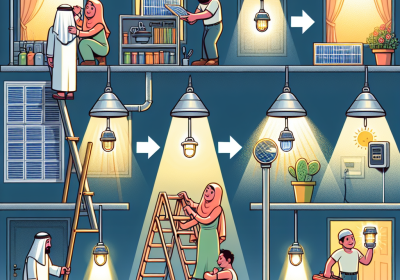Temporary Solar Lighting for Disaster Relief
Table of Contents
Temporary solar lighting for disaster relief is an innovative and sustainable solution designed to provide immediate illumination in areas affected by natural or man-made disasters. These portable lighting systems harness solar energy to generate light, ensuring that essential services can continue to operate even when traditional power sources are unavailable. By utilizing renewable energy, temporary solar lighting reduces dependency on fossil fuels, minimizes environmental impact, and offers a reliable source of light during critical times. These systems are crucial for enhancing safety, facilitating rescue operations, and supporting recovery efforts in disaster-stricken regions.

Benefits Of Temporary Solar Lighting In Disaster Relief Efforts
Temporary solar lighting has emerged as a crucial asset in disaster relief efforts, offering a range of benefits that significantly enhance the efficiency and effectiveness of emergency response. In the aftermath of natural disasters, such as hurricanes, earthquakes, and floods, traditional power infrastructure is often severely compromised, leaving affected areas in darkness. This lack of illumination can exacerbate the challenges faced by both survivors and relief workers. Consequently, the deployment of temporary solar lighting systems can play a pivotal role in mitigating these challenges.
One of the primary advantages of temporary solar lighting is its ability to provide immediate illumination without the need for an existing power grid. Solar lighting systems harness energy from the sun, storing it in batteries for use during nighttime or cloudy conditions. This independence from conventional power sources ensures that lighting can be quickly established in disaster-stricken areas, facilitating search and rescue operations, medical care, and the distribution of essential supplies. Moreover, the rapid deployment of solar lighting can help restore a sense of normalcy and security for affected communities, reducing the risk of accidents and crime that often accompany prolonged periods of darkness.
In addition to providing immediate relief, temporary solar lighting is also environmentally sustainable. Traditional emergency lighting solutions, such as diesel generators, not only require a continuous supply of fuel but also emit harmful pollutants. In contrast, solar lighting systems operate cleanly and quietly, minimizing the environmental impact of disaster relief operations. This sustainability is particularly important in the context of climate change, as it aligns with broader efforts to reduce carbon emissions and promote renewable energy sources.
Furthermore, the cost-effectiveness of temporary solar lighting cannot be overlooked. While the initial investment in solar lighting systems may be higher than that of conventional alternatives, the long-term savings are substantial. Solar lighting systems have low operational and maintenance costs, as they do not rely on fuel and have fewer mechanical components that can fail. Over time, these savings can be redirected towards other critical aspects of disaster relief, such as food, water, and medical supplies. Additionally, the durability and reliability of solar lighting systems ensure that they can be reused in future disaster scenarios, providing a return on investment that extends beyond a single event.
Another significant benefit of temporary solar lighting is its versatility and adaptability. Solar lighting systems come in various forms, including portable lanterns, streetlights, and floodlights, allowing them to be tailored to the specific needs of different disaster situations. For instance, portable lanterns can be distributed to individual households, providing personal lighting for families, while larger streetlights can illuminate public spaces, enhancing safety and enabling nighttime activities. This flexibility ensures that solar lighting can be effectively integrated into a wide range of disaster relief strategies.
Moreover, the use of temporary solar lighting can foster community resilience and empowerment. By providing a reliable source of light, solar systems enable communities to continue their daily activities, such as cooking, studying, and socializing, even in the absence of grid power. This continuity is vital for maintaining morale and supporting the psychological well-being of disaster survivors. Additionally, the deployment of solar lighting can create opportunities for local employment and skill development, as community members may be trained to install, maintain, and operate the systems.
In conclusion, temporary solar lighting offers a multitude of benefits in disaster relief efforts, from providing immediate and sustainable illumination to enhancing cost-effectiveness and community resilience. As the frequency and intensity of natural disasters continue to rise, the adoption of solar lighting solutions will become increasingly important in ensuring that relief operations are both effective and environmentally responsible.
How To Implement Temporary Solar Lighting In Emergency Situations
Implementing temporary solar lighting in emergency situations requires a well-coordinated approach to ensure that affected areas receive adequate illumination promptly. The first step in this process involves assessing the specific needs of the disaster-stricken region. This assessment should include evaluating the extent of the damage, the number of people affected, and the critical areas that require immediate lighting, such as medical facilities, shelters, and key access routes. By understanding these needs, responders can prioritize the deployment of solar lighting systems effectively.
Once the assessment is complete, the next phase involves selecting appropriate solar lighting solutions. Various types of solar lights are available, including portable solar lanterns, solar street lights, and solar floodlights. Each type serves different purposes; for instance, portable solar lanterns are ideal for individual use in shelters, while solar street lights can illuminate larger outdoor areas. It is crucial to choose reliable and durable products that can withstand harsh environmental conditions often present in disaster zones.
After selecting the appropriate solar lighting solutions, the logistics of transportation and distribution must be meticulously planned. Given the urgency of disaster relief efforts, it is essential to have a streamlined supply chain to ensure that solar lighting systems reach the affected areas swiftly. Coordination with local authorities, non-governmental organizations, and international aid agencies can facilitate the efficient distribution of these resources. Additionally, pre-positioning solar lighting kits in disaster-prone regions can significantly reduce response times.
Upon arrival at the disaster site, the installation of solar lighting systems should be carried out by trained personnel. Proper installation is critical to ensure the optimal performance of the lights. For instance, solar panels must be positioned to receive maximum sunlight exposure, and batteries should be securely connected to store energy effectively. Training local volunteers or community members in the installation and maintenance of these systems can also be beneficial, as it empowers the community to manage the lighting solutions independently.
Furthermore, it is important to consider the sustainability and longevity of the solar lighting systems. Regular maintenance, such as cleaning solar panels and checking battery health, is necessary to ensure continuous operation. Establishing a maintenance schedule and providing the necessary tools and training to local communities can help in maintaining the functionality of the lighting systems over time. Additionally, having a plan for the eventual disposal or recycling of solar components is essential to minimize environmental impact.
In addition to the technical aspects, the implementation of temporary solar lighting in emergency situations also involves addressing social and cultural factors. Engaging with the local community and understanding their specific needs and preferences can enhance the acceptance and effectiveness of the lighting solutions. For example, involving community leaders in the planning and decision-making process can foster a sense of ownership and cooperation.
Moreover, it is vital to integrate solar lighting solutions into broader disaster response strategies. Solar lighting can complement other relief efforts, such as providing clean water, medical aid, and food supplies. By ensuring that key areas are well-lit, solar lighting can enhance the safety and security of both the affected population and relief workers, thereby improving the overall efficiency of the disaster response.
In conclusion, the successful implementation of temporary solar lighting in emergency situations hinges on thorough planning, effective coordination, and community involvement. By addressing the technical, logistical, and social aspects of deployment, responders can provide reliable and sustainable lighting solutions that significantly improve the living conditions and safety of disaster-affected communities.
Case Studies: Successful Uses Of Temporary Solar Lighting In Disaster Zones
In recent years, temporary solar lighting has emerged as a vital resource in disaster relief efforts, providing essential illumination in areas where traditional power infrastructure has been compromised. Numerous case studies highlight the successful deployment of solar lighting in disaster zones, demonstrating its efficacy and versatility in various emergency scenarios. These instances not only underscore the practicality of solar technology but also emphasize its potential to save lives and facilitate recovery in the aftermath of natural disasters.
One notable example is the aftermath of the 2010 earthquake in Haiti, which left the nation in darkness and chaos. The earthquake, which measured 7.0 on the Richter scale, caused widespread devastation, including the collapse of buildings and the destruction of the electrical grid. In response, several humanitarian organizations, including the United Nations and various non-governmental organizations (NGOs), deployed temporary solar lighting systems to provide immediate relief. These solar lights were instrumental in illuminating makeshift camps and medical facilities, thereby enhancing safety and security for the affected population. The availability of light not only deterred criminal activities but also enabled medical personnel to perform critical procedures during nighttime hours, significantly improving the overall response efforts.
Similarly, in the wake of Typhoon Haiyan in the Philippines in 2013, temporary solar lighting played a crucial role in the recovery process. The typhoon, one of the most powerful ever recorded, caused extensive damage to infrastructure, leaving millions without electricity. In the immediate aftermath, solar lighting kits were distributed to affected communities, providing a reliable source of light in the absence of conventional power. These kits, which included solar lanterns and portable solar panels, were particularly beneficial in remote areas where access to aid was limited. The deployment of solar lighting not only facilitated nighttime activities but also contributed to a sense of normalcy and psychological comfort for the survivors.
Transitioning to another significant case, the 2015 earthquake in Nepal serves as a testament to the adaptability of solar lighting in diverse disaster scenarios. The earthquake, which struck with a magnitude of 7.8, resulted in severe damage to the country’s infrastructure, including the electrical grid. In response, various international aid organizations collaborated to provide temporary solar lighting solutions to the affected regions. These efforts included the distribution of solar-powered lanterns and the installation of solar streetlights in key areas such as hospitals, schools, and community centers. The implementation of solar lighting not only addressed the immediate need for illumination but also supported long-term recovery by enabling educational and economic activities to resume more quickly.
Moreover, the use of temporary solar lighting has proven effective in addressing the unique challenges posed by prolonged power outages following natural disasters. For instance, in Puerto Rico, after Hurricane Maria struck in 2017, the island experienced an unprecedented power crisis, with many areas remaining without electricity for months. In this context, solar lighting systems provided a critical lifeline, offering a sustainable and resilient solution to the ongoing power shortages. The deployment of solar lights in public spaces, residential areas, and emergency shelters significantly improved living conditions and supported the overall recovery efforts.
In conclusion, the successful use of temporary solar lighting in disaster zones across the globe highlights its indispensable role in emergency response and recovery. These case studies illustrate how solar technology can provide immediate relief, enhance safety and security, and support long-term rebuilding efforts in the aftermath of natural disasters. As the frequency and intensity of such events continue to rise, the importance of integrating sustainable solutions like solar lighting into disaster preparedness and response strategies cannot be overstated.
Read more about Temporary Solar Lighting
- Introduction to Temporary Solar Lighting
- Advantages of Temporary Solar Lighting
- Temporary Solar Lighting for Events and Festivals
- Temporary Solar Lighting for Construction Sites
- Temporary Solar Lighting for Outdoor Recreation
- Temporary Solar Lighting for Parking Lots and Garages
- Temporary Solar Lighting for Road and Highway Construction
- Temporary Solar Lighting for Military and Security Operations
- Choosing, Installing, and Maintaining Temporary Solar Lighting









